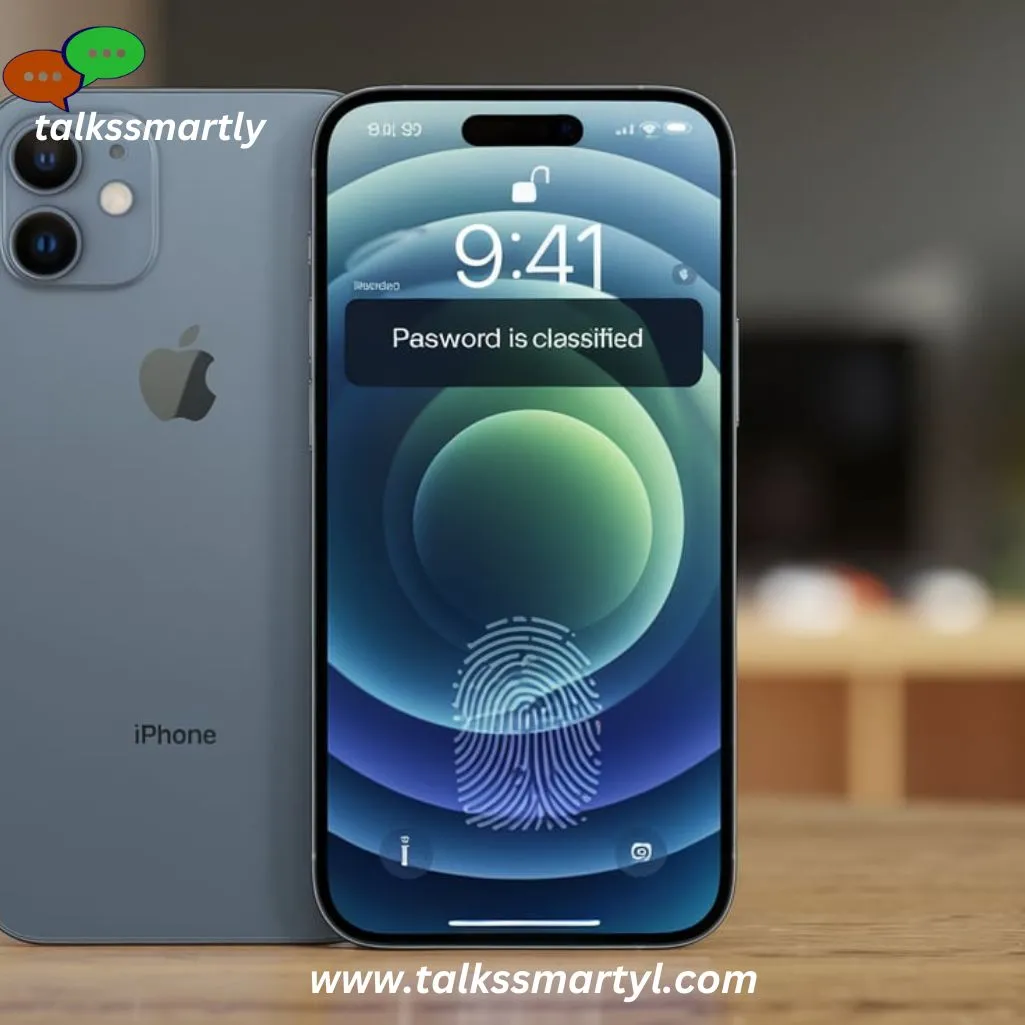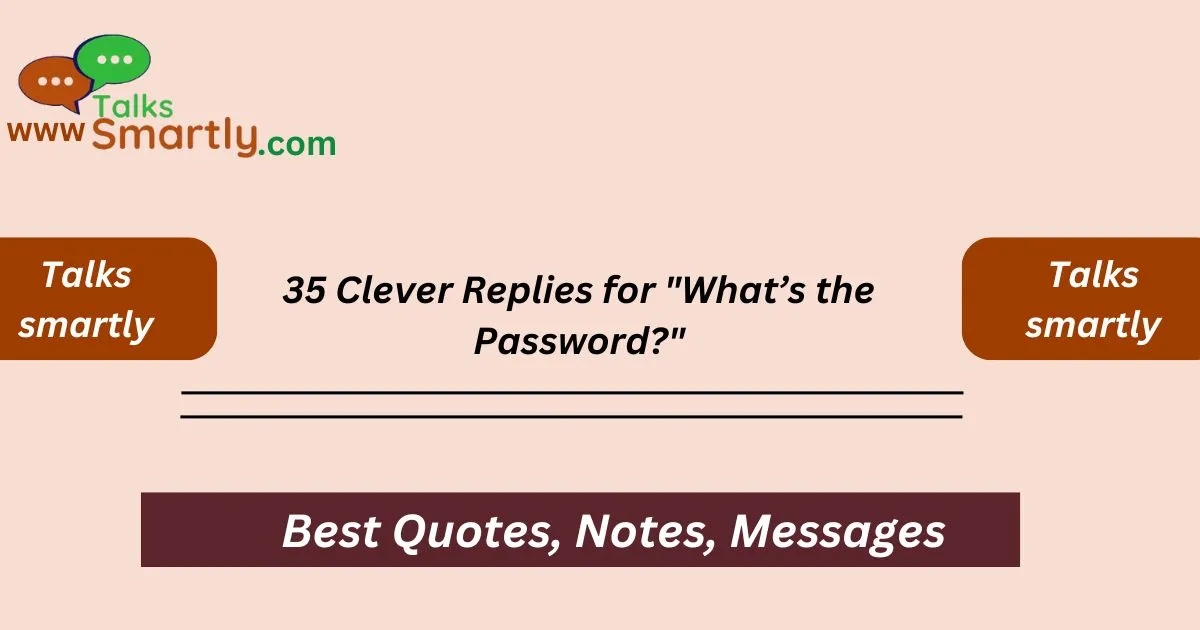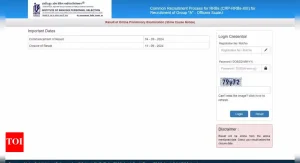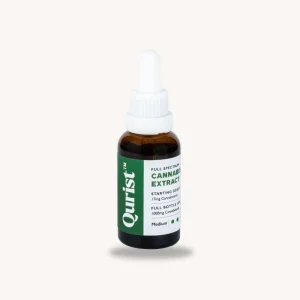“When someone asks, “What’s the password” it’s often an opportunity to have a little fun while keeping things secure”
A clever response not only entertains but can also help keep the mood light. Whether you’re dealing with a tech-savvy friend or a curious colleague, a witty reply can make the interaction memorable.
Using clever replies to “What’s the password?” can be a great way to break the ice and add a bit of humor to your interactions. It’s not just about having fun; it’s also about creating a positive atmosphere and engaging in a light-hearted exchange. Clever responses can help you stand out and leave a lasting impression.
Clever replies add personality and charm to everyday conversations. They can make routine interactions more enjoyable and help you connect with others on a different level. By choosing the right response, you can keep conversations lively and engaging, while also showing off your sense of humor.
35 Clever Replies for “What’s the Password?”
- “It’s 1234—just kidding, that’s the password to my diary!”
- “I’d tell you, but then I’d have to give you a secret handshake.”
- “The password is ‘correcthorsebatterystaple’—try saying that three times fast!”
- “I’m sorry, but the password is classified. Only secret agents can know.”
- “I’d tell you, but then I’d have to take you out for coffee first.”
- “The password is ‘OpenSesame’—but you have to say it with a magic spell!”
- “It’s ‘please’—because asking nicely always works.”
- “The password is ‘password’. Just kidding, who uses that anyway?”
- “I could tell you, but then I’d have to dance a jig.”
- “Try ‘LetMeIn’—if that doesn’t work, you might need to sing a song.”
- “The password is ‘SuperSecret123’. Just don’t tell anyone!”
- “It’s ‘abracadabra’. If you believe in magic, it might just work.”
- “I can’t tell you the password, but I can share a joke instead.”
- “The password is ‘ILikeCookies’. It’s a sweet deal, isn’t it?”
- “Sorry, the password is a riddle. Solve it and you’ll get in.”
- “Try ‘GuessAgain’. It’s more fun this way!”
- “The password is ‘You’reAlmostThere’. Just a little more effort!”
- “It’s ‘OpenSesame123’. But don’t get too used to it!”
- “The password is ‘Nope’. Just kidding—try ‘LetMeIn’.”
- “I’d tell you, but it’s a closely guarded secret. How about a hint?”
- “The password is ‘12345’. Wait, that’s too obvious!”
- “It’s ‘SurpriseMe’. The more creative, the better!”
- “I’m afraid I can’t tell you. How about a funny face instead?”
- “Try ‘KnockKnock’. It might be the key to getting through.”
- “The password is ‘YouCanDoIt’. Keep trying!”
- “It’s ‘AlmostThere’. Just a little bit more!”
- “The password is ‘OpenSaysMe’. But don’t tell anyone!”
- “Try ‘HiddenGem’. You’re on the right track!”
- “The password is ‘TopSecret’. And I mean it!”
- “It’s ‘GuessWhat’. I bet you can figure it out.”
- “I’d love to tell you, but then it wouldn’t be a secret.”
- “The password is ‘Shhh’. It’s a silent code!”
- “It’s ‘Password123’. But seriously, who uses that?”
- “Try ‘YouGotThis’. It’s motivational, too!”
- “The password is ‘FunTimes’. Because everyday should be fun!”
1. “It’s 1234—just kidding, that’s the password to my diary!”
This reply plays on the idea of an absurdly simple password, making a joke about its triviality.
Example: “What’s the password?”
“It’s 1234—just kidding, that’s the password to my diary!”
This response adds humor by pretending the password is something as personal as a diary.
2. “I’d tell you, but then I’d have to give you a secret handshake.”
This reply uses the concept of a secret handshake to make the password sound more exclusive and fun.
Example: “What’s the password?”
“I’d tell you, but then I’d have to give you a secret handshake.”
This adds an element of playful secrecy to the response.
3. “The password is ‘correct horse battery staple’—try saying that three times fast!”
Refers to a famous example of a strong password, adding humor by suggesting it’s difficult to say.
Example: “What’s the password?”
“The password is ‘correct horse battery staple’—try saying that three times fast!”
This makes the password seem complex and fun to pronounce.
4. “I’m sorry, but the password is classified. Only secret agents can know.”

Jokes about the password being classified, giving it an air of importance and secrecy.
Example: “What’s the password?”
“I’m sorry, but the password is classified. Only secret agents can know.”
This response adds a layer of intrigue and humor.
5. “I’d tell you, but then I’d have to take you out for coffee first.”
Suggests that sharing the password is a special occasion, humorously implying a social requirement.
Example: “What’s the password?”
“I’d tell you, but then I’d have to take you out for coffee first.”
This makes the password exchange seem like a special event.
6. “The password is ‘OpenSesame’—but you have to say it with a magic spell!”
Uses a magical reference to make the password sound whimsical and fun.
Example: “What’s the password?”
“The password is ‘OpenSesame’—but you have to say it with a magic spell!”
This adds a playful, magical touch to the response.
7. “It’s ‘please’—because asking nicely always works.”
Suggests that being polite is the key, adding humor by implying the password is just a polite request.
Example: “What’s the password?”
“It’s ‘please’—because asking nicely always works.”
This makes politeness the punchline.
8. “The password is ‘password’. Just kidding, who uses that anyway?”
References the common bad practice of using ‘password’ as a password, adding humor by mocking it.
Example: “What’s the password?”
“The password is ‘password’. Just kidding, who uses that anyway?”
This is a self-aware joke about poor password practices.
9. “I could tell you, but then I’d have to dance a jig.”
Humorously suggests that revealing the password requires a silly dance, adding an entertaining twist.
Example: “What’s the password?”
“I could tell you, but then I’d have to dance a jig.”
This makes the password reveal sound like a fun challenge.
10. “Try ‘LetMeIn’—if that doesn’t work, you might need to sing a song.”
Offers a creative password while adding a humorous suggestion of singing to gain access.
Example: “What’s the password?”
“Try ‘LetMeIn’—if that doesn’t work, you might need to sing a song.”
This combines a plausible password with a humorous twist.
11. “The password is ‘SuperSecret123’. Just don’t tell anyone!”
Provides a seemingly secure password while humorously emphasising secrecy.
Example: “What’s the password?”
“The password is ‘SuperSecret123’. Just don’t tell anyone!”
This adds an ironic emphasis on secrecy.
12. “It’s ‘abracadabra’. If you believe in magic, it might just work.”
Uses a magic word as the password, making the situation feel whimsical and fun.
Example: “What’s the password?”
“It’s ‘abracadabra’. If you believe in magic, it might just work.”
This response adds a magical flair to the password.
13. “I can’t tell you the password, but I can share a joke instead.”
Redirects from giving the password to telling a joke, adding humor and a personal touch.
Example: “What’s the password?”
“I can’t tell you the password, but I can share a joke instead.”
This shifts the focus to humor.
14. “The password is ‘ILikeCookies’. It’s a sweet deal, isn’t it?”
Uses a playful and specific password, making the response both humorous and memorable.
Example: “What’s the password?”
“The password is ‘ILikeCookies’. It’s a sweet deal, isn’t it?”
This adds a fun personal touch to the password.
15. “Sorry, the password is a riddle. Solve it and you’ll get in.”
Introduces a riddle element, making the password reveal a game.
Example: “What’s the password?”
“Sorry, the password is a riddle. Solve it and you’ll get in.”
This turns the password request into a playful challenge.
Funny Responses to “Don’t Flatter Yourself”
16. “Try ‘GuessAgain’. It’s more fun this way!”
Uses a playful response to imply that guessing is part of the fun.
Example: “What’s the password?”
“Try ‘GuessAgain’. It’s more fun this way!”
This adds an element of playfulness.
17. “The password is ‘You’reAlmostThere’. Just a little more effort!”
Encourages persistence with a playful and motivational response.
Example: “What’s the password?”
“The password is ‘You’reAlmostThere’. Just a little more effort!”
This response is both encouraging and fun.
18. “It’s ‘OpenSesame123’. But don’t get too used to it!”
Provides a fun password while humorously suggesting it’s not permanent.
Example: “What’s the password?”
“It’s ‘OpenSesame123’. But don’t get too used to it!”
This combines a playful password with a light warning.
19. “The password is ‘Nope’. Just kidding—try ‘LetMeIn’.”
Starts with a humorous “Nope” and then gives a real password, adding a twist.
Example: “What’s the password?”
“The password is ‘Nope’. Just kidding—try ‘LetMeIn’.”
This adds a twist to the response, making it humorous.
20. “I’d tell you, but it’s a closely guarded secret. How about a hint?”
Jokes about the password being a secret, while offering a hint instead.
Example: “What’s the password?”
“I’d tell you, but it’s a closely guarded secret. How about a hint?”
This adds a playful layer of secrecy.
21. “The password is ‘12345’. Wait, that’s too obvious!”
Uses an obviously poor password as a joke, implying it’s not serious.
Example: “What’s the password?”
“The password is ‘12345’. Wait, that’s too obvious!”
This highlights a common mistake in password security humorously.
22. “It’s ‘SurpriseMe’. The more creative, the better!”
Encourages creativity with a fun and open-ended password.
Example: “What’s the password?”
“It’s ‘SurpriseMe’. The more creative, the better!”
This adds an element of surprise and creativity.
23. “I’m afraid I can’t tell you. How about a funny face instead?”
Offers a humorous alternative to sharing the password.
Example: “What’s the password?”
“I’m afraid I can’t tell you. How about a funny face instead?”
This response adds humor by suggesting a funny face as an alternative.
24. “Try ‘KnockKnock’. It might be the key to getting through.”
Uses a common joke format as a playful hint for the password.
Example: “What’s the password?”
“Try ‘KnockKnock’. It might be the key to getting through.”
This incorporates a well-known joke structure into the response.
25. “The password is ‘YouCanDoIt’. Keep trying!”
Provides a motivational password, encouraging persistence.
Example: “What’s the password?”
“The password is ‘YouCanDoIt’. Keep trying!”
This adds a motivational twist to the password inquiry.
26. “It’s ‘AlmostThere’. Just a little bit more!”
Uses a password that implies the user is close to success.
Example: “What’s the password?”
“It’s ‘AlmostThere’. Just a little bit more!”
This keeps the mood light while suggesting effort is needed.
27. “The password is ‘OpenSaysMe’. But don’t tell anyone!”

Uses a playful variation of a magical phrase, adding a humorous touch.
Example: “What’s the password?”
“The password is ‘OpenSaysMe’. But don’t tell anyone!”
This response adds a touch of whimsy to the password.
28. “Try ‘HiddenGem’. You’re on the right track!”
Provides a password that suggests the user is close to the answer.
Example: “What’s the password?”
“Try ‘HiddenGem’. You’re on the right track!”
This keeps the interaction engaging and encouraging.
29. “The password is ‘TopSecret’. And I mean it!”
Emphasises the secrecy of the password with a humorous tone.
Example: “What’s the password?”
“The password is ‘TopSecret’. And I mean it!”
This response humorously underscores the password’s secrecy.
30. “It’s ‘GuessWhat’. I bet you can figure it out.”
Turns the password reveal into a guessing game, adding fun.
Example: “What’s the password?”
“It’s ‘GuessWhat’. I bet you can figure it out.”
This makes the password request into an interactive challenge.
31. “I’d love to tell you, but then it wouldn’t be a secret.”
Plays on the idea of maintaining secrecy for the password.
Example: “What’s the password?”
“I’d love to tell you, but then it wouldn’t be a secret.”
This humorously keeps the password a mystery.
32. “The password is ‘Shhh’. It’s a silent code!”
Uses a playful approach by suggesting a silent code, adding humor.
Example: “What’s the password?”
“The password is ‘Shhh’. It’s a silent code!”
This response adds a playful, secretive touch.
33. “It’s ‘Password123’. But seriously, who uses that?”
Jokes about using a common, insecure password, adding humor.
Example: “What’s the password?”
“It’s ‘Password123’. But seriously, who uses that?”
This highlights a poor password practice in a humorous way.
34. “Try ‘YouGotThis’. It’s motivational, too!”
Uses a motivational phrase as the password, adding encouragement.
Example: “What’s the password?”
“Try ‘YouGotThis’. It’s motivational, too!”
This makes the password both encouraging and fun.
35. “The password is ‘FunTimes’. Because every day should be fun!”
Chooses a fun and positive password, making the interaction cheerful.
Example: “What’s the password?”
“The password is ‘FunTimes’. Because every day should be fun!”
This adds a cheerful note to the password request.
ANSWER TO KEY QUESTION
1. What if someone asks for a password in a professional setting?
In a professional setting, it’s best to be straightforward and provide the actual password if appropriate. If security is a concern, follow the organization’s protocol.
2. How can I create a clever password response without compromising security?
You can use playful language or creative phrases that don’t reveal any real passwords or sensitive information. Make sure your actual passwords are secure and follow best practices.
3. Is it appropriate to use humor when giving a password?
It depends on the context. In casual settings, humor can be fun and engaging. In formal or sensitive situations, it’s important to prioritize security over humor.
4. How can I ensure that my responses are both clever and secure?
Always ensure that any humorous responses are not actual passwords or hints. Keep your real passwords secure and use humor in a way that doesn’t compromise security.
5. Can clever responses be used for other security questions?
Yes, you can use clever responses for other types of security questions, but always ensure that the actual answers are secure and follow best practices.
Conclusion
Responding to “What’s the password?” with clever and humorous replies can be a fun way to engage with others while keeping things light-hearted. These responses not only provide entertainment but also help in maintaining a positive atmosphere.
Just remember to keep your actual passwords secure and use creativity responsibly. With these 35 clever replies, you’ll be well-equipped to handle the question with style and wit!

Hi, I’m Lauren Reynolds, owner of Talks Smartly.
We specialize in wishes, thank you messages, and thoughtful responses for all occasions.
Whether it’s a birthday wish or a heartfelt thank you, we’re here to make your messages shine.
Join us at Talks Smartly and let your words leave a lasting impression.”











